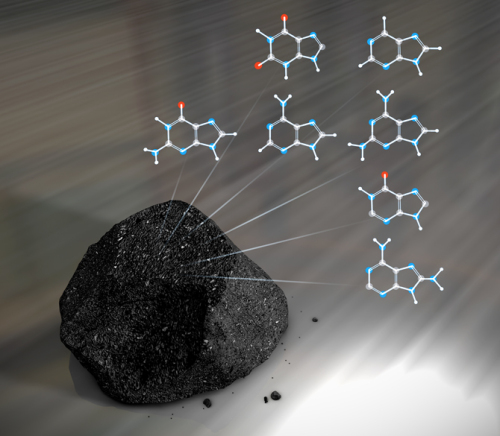A new analysis of carbon meteorites suggests that they likely carried some of the building blocks needed for DNA to the Earth, according to a NASA-funded study published on Monday.

The research in the Proceedings of the National Academy of Sciences adds weight to the long-debated theory that at least some of the materials needed to make early life forms came to our planet via meteorites.
Although building blocks of DNA in meteorites were found in the 1960s, scientists have been unclear as to whether they originate from space or contamination by terrestrial life.
Researchers at the Goddard Astrobiology Analytical Laboratory funded by NASA, found three lines of evidence that confidently support the idea that life on Earth has its origins in outer space.
According to NASA, Goddard team collected the powdered samples of 12 carbon-rich meteorites, nine of which were recovered from Antarctica
In the course of a scientific examination to determine the chemical structure of compounds, the team found adenine and guanine, the building blocks of DNA, which are also referred to as nucleobases.
Moreover, in two of the meteorites, the team discovered for the first time trace amounts of three molecules related to nucleobases: purine, 2,6-diaminopurine, and 6,8-diaminopurine.
While the latter two molecules are almost never used in biology, such nucleobase-related molecules, called nucleobase analogs prove the compounds in the meteorites come from space instead of terrestrial contamination.
“You would not expect to see these nucelo base analogs if contamination from terrestrial life was the source, because they are not used in biology,” said Dr. Michael Callahan of NASA’s Goddard.
Follow-up research on an eight-kilogram sample of ice from Antarctica involving the same methods used on the meteorites, provided the second piece of evidence.
None of the nucleobase analogs were detected in the ice sample, further ruling out possibility of terrestrial contamination as an origin of life.
Lastly, the Goddard team found that the above-mentioned molecules were produced in a completely non-biological reaction, confirming by generating an identical suite of nucleobases and nucleobase analogs artificially, in the lab.
NASA’s findings have far-reaching implications as it is highly likely that DNA compositions of early life on Earth originate from outer space.
By Jung Eun-jung and news reports
(kristin2j@gmail.com)
Intern reporter
Edited by Rob York
<관련 한글 기사>
지구 초기 생명체 성분..우주로부터
(서울=연합뉴스) 우주로부터 날아온 운석에서 지구에는 없는 DNA 구성 물질과 함께 세포 호흡에 관여하는 분자들도 발견돼 지구 초기 생명체 성분 가운데 최소한 일부는 운석을 통해 전달됐다는 가설이 큰 힘을 얻게 됐다고 스페이스 닷컴이 8일 두 개의 최신 연구를 인용 보도했다.
미항공우주국(NASA)의 지원을 받은 카네기연구소 과학자들은 유기물 성분이 풍부한 탄소질 구립(球粒)운석 11개를 첨단 질량분석법으로 분석한 결과 DNA와 RNA 구 성에 필요한 염기를 찾았다고 미국립과학원회보(PNAS)에서 밝혔다.
한편 NASA 에임즈 연구소의 한 화학자는 탄소질 구립운석을 분석한 다른 연구에 서 생명체 안의 에너지 생성을 위한 `시트르산 회로’의 핵심 성분인 분자들을 발견했다고 역시 PNAS에 발표했다.
짐 클리브스를 비롯한 카네기연구소의 화학자들은 탄소질 구립운석에 퓨린과 6,8 디아미노퓨린, 2,6 디아미노퓨린 등 세 종류의 염기가 광범위하게 분포돼 있었으며 이런 성분은 지구 생물계에는 없거나 매우 희귀한 것이라고 지적했다.
연구진은 운석들이 떨어진 곳의 흙이나 얼음 표본에서 이들 세 가지 성분이 의미 있는 수준의 농도를 보이지 않았다면서 “지구 생화학계에서 일반적으로 발견되지 않는 염기 성분들이 발견된 것은 생명체의 외계 기원 가설을 강력히 뒷받침하는 것”이라고 주장했다.
학자들은 이 발견은 “운석들이 지구상의 생명체를 만드는 필수 성분을 공급하는 일종의 분자 도구 세트였을 가능성을 보여주는 것”이라고 강조했다.
과거 다른 과학자들도 일부 운석에서 염기를 발견했으나 그 특징이 지구상에 이 미 존재하는 염기와 같은 것이어서 지구 물질로 오염됐을 가능성으로 논란을 빚어왔다.
앞서 NASA의 한 과학자가 여러 종류의 탄소질 구립운석 속에서 고대 박테리아 화석의 흔적이 발견됐다고 주장했으나 NASA는 이런 연구와 거리를 두어 왔다.
한편 에임즈 연구소의 화학자 조지 쿠퍼는 여러 개의 탄소질 구립 운석에서 시트르산 순환을 발견했다고 밝혔다. 그는 시트르산 회로는 “많은 과학자가 최고(最古)의 생명 현상이라고 생각해 온 것으로서 호흡 기능을 갖고 있다”고 설명했다.
지구 초기 생명체 성분..우주로부터
(서울=연합뉴스) 우주로부터 날아온 운석에서 지구에는 없는 DNA 구성 물질과 함께 세포 호흡에 관여하는 분자들도 발견돼 지구 초기 생명체 성분 가운데 최소한 일부는 운석을 통해 전달됐다는 가설이 큰 힘을 얻게 됐다고 스페이스 닷컴이 8일 두 개의 최신 연구를 인용 보도했다.
미항공우주국(NASA)의 지원을 받은 카네기연구소 과학자들은 유기물 성분이 풍부한 탄소질 구립(球粒)운석 11개를 첨단 질량분석법으로 분석한 결과 DNA와 RNA 구 성에 필요한 염기를 찾았다고 미국립과학원회보(PNAS)에서 밝혔다.
한편 NASA 에임즈 연구소의 한 화학자는 탄소질 구립운석을 분석한 다른 연구에 서 생명체 안의 에너지 생성을 위한 `시트르산 회로’의 핵심 성분인 분자들을 발견했다고 역시 PNAS에 발표했다.
짐 클리브스를 비롯한 카네기연구소의 화학자들은 탄소질 구립운석에 퓨린과 6,8 디아미노퓨린, 2,6 디아미노퓨린 등 세 종류의 염기가 광범위하게 분포돼 있었으며 이런 성분은 지구 생물계에는 없거나 매우 희귀한 것이라고 지적했다.
연구진은 운석들이 떨어진 곳의 흙이나 얼음 표본에서 이들 세 가지 성분이 의미 있는 수준의 농도를 보이지 않았다면서 “지구 생화학계에서 일반적으로 발견되지 않는 염기 성분들이 발견된 것은 생명체의 외계 기원 가설을 강력히 뒷받침하는 것”이라고 주장했다.
학자들은 이 발견은 “운석들이 지구상의 생명체를 만드는 필수 성분을 공급하는 일종의 분자 도구 세트였을 가능성을 보여주는 것”이라고 강조했다.
과거 다른 과학자들도 일부 운석에서 염기를 발견했으나 그 특징이 지구상에 이 미 존재하는 염기와 같은 것이어서 지구 물질로 오염됐을 가능성으로 논란을 빚어왔다.
앞서 NASA의 한 과학자가 여러 종류의 탄소질 구립운석 속에서 고대 박테리아 화석의 흔적이 발견됐다고 주장했으나 NASA는 이런 연구와 거리를 두어 왔다.
한편 에임즈 연구소의 화학자 조지 쿠퍼는 여러 개의 탄소질 구립 운석에서 시트르산 순환을 발견했다고 밝혔다. 그는 시트르산 회로는 “많은 과학자가 최고(最古)의 생명 현상이라고 생각해 온 것으로서 호흡 기능을 갖고 있다”고 설명했다.



![[Exclusive] Korean military set to ban iPhones over 'security' concerns](http://res.heraldm.com/phpwas/restmb_idxmake.php?idx=644&simg=/content/image/2024/04/23/20240423050599_0.jpg&u=20240423183955)
![[AtoZ into Korean mind] Humor in Korea: Navigating the line between what's funny and not](http://res.heraldm.com/phpwas/restmb_idxmake.php?idx=644&simg=/content/image/2024/04/22/20240422050642_0.jpg&u=)


![[Graphic News] 77% of young Koreans still financially dependent](http://res.heraldm.com/phpwas/restmb_idxmake.php?idx=644&simg=/content/image/2024/04/22/20240422050762_0.gif&u=)




![[Pressure points] Leggings in public: Fashion statement or social faux pas?](http://res.heraldm.com/phpwas/restmb_idxmake.php?idx=644&simg=/content/image/2024/04/23/20240423050669_0.jpg&u=)


![[LLG] Why this tutor teaches for free](http://res.heraldm.com/phpwas/restmb_idxmake.php?idx=652&simg=/content/image/2024/04/24/20240424050572_0.jpg&u=)



![[Today’s K-pop] Ateez confirms US tour details](http://res.heraldm.com/phpwas/restmb_idxmake.php?idx=642&simg=/content/image/2024/04/23/20240423050700_0.jpg&u=)